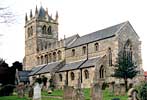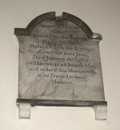For this church:    |
| |||||||||||||||||||||||||||||||||
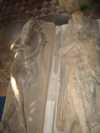 |
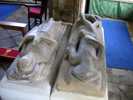 |
Effigies of Robert and |
|
Robert Everingham, d1287. Mansfield stone. A baron in the reign of Henry II, who made Laxton his principal home; last of the chief lords of Laxton and hereditary chief keeper or custodian of the royal forests of Nottingham and Derby. Knight of King Edward I, and possibly a participant in the crusade led by Prince Edward, 1270-74. Clad in armour of ring-mail.
Adam de Everingham
Baron Adam de Everingham, d1371. Mansfield stone. This was ‘Adam de Everingham de Laxton’, who was summoned to Parliament on 8 January 1371, and fought at Cressy. An early appearance of plate armour, which later became general. Depicted in the attitude of using the sword, held by some to imply that the knight fell in battle. Late example of the crossed legs and the shield on the left arm.
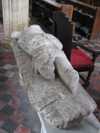 |
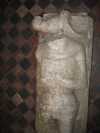 |
Reginald de Everingham
Baron Reginald de Everingham, d1399. Alabaster. A headless trunk. The sword belt is worn horizontally across the hips and is decorated with metal plates. The sword has moved to the left side, and a new instrument, the misericordia, or dagger, on the right side.
North side
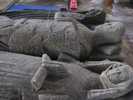 |
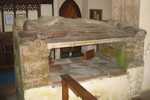 |
Adam de Everingham and wives Clarice and Margery
Adam de Everingham (c1280-c1336). Aubigny marble. Son of Robert Everingham (d1287), with lion carved on shield. Served in the Scottish war of 1303 and in 1306 Edward I conferred the Knighthood of the Bath on him. In 1309 King Edward created him Baron Everingham, of Laxton, but he later took up arms against the king and was taken prisoner at the Battle of Boroughbridge in March 1322 and had to pay a ransom of 400 marks to secure his release.
His first wife Clarice, died without issue. Aubigny marble.The statues of Adam and Clarice are in white limestone from Aubigny and are the work of the same sculptor, suggesting that they were carved at the same time, possibly about 1325 on her death. She is depicted as wearing the wimple of the period, a handkerchief tied around the neck, chest and chin and caught up behind the head, over which is the veil, here drawn aside, the ends falling down upon the shoulders with a retaining band across the forehead.
His second wife Margery. The oak effigy of Margery (d1336), by whom Adam had a son and heir, Adam, called the younger, is the only surviving wooden (oak) medieval effigy in Nottinghamshire. Head dress similar to that of Clarice.
The three figures are on a tomb probably built c1250 by the Lexingtons and canopied on similar lines to the tomb of Amyer de Valence in Westminster Abbey. Subsequently cut down to form a resting place for these monuments, whose original place would have been in the de Everingham chapel on the south side of the Chancel. The figures have been cut away to fit into their present position.
Location
Although the monument to Adam de Everingham and his two wives looks to have remained in its current location since it was placed there, the other three monuments have moved from time to time. Thoroton (1677) noted ‘three old low cross legg’d stone tombs and a blue grave stone in brass’. He noted also the Everingham lion rampant painted on the breast of an effigy on an alabaster tomb ‘on the south side the Quire’. Cox (1700) referred to ‘three old low cross-legged stone tombs’, which indicates that Reginald de Everingham was then in better condition than today. He noted also a ‘a monument of blue stone, for Mr Roger Morecaunt, Rector, who died December 17, 1438’.
Throsby noted in the north chapel ‘an old tomb almost 6 feet high, on which lie three figures, seemingly a knight and his two wives; but so covered with dust, that I found it difficult to sketch them’. The alabaster monument was ‘in the chancel’, and he noted also in the south aisle ‘a loose head, probably once belonging to the trunk above named. Near which lies part of a cross legged knight.’
When Sir Stephen Glynne visited in 1854 he noted the tomb of Adam de Everingham and his two wives, and a ‘mutilated effigy of a cross-legged knight’ which implies that one of the three monuments now in the south aisle was then in the north aisle. This would make sense, given that the south aisle had been closed off as the school room, but it is unlikely that Glynne would have failed to mention the other two monuments if they had been inside the church.
In 1902 the three effigies lay side by side, but subsequently Reginald was moved to the west and is now the other side of a pillar, making access to the southern chapel easier.
Other memorials
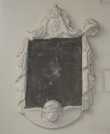 Chancel south wall
Chancel south wall
A wall mounted monument, well above eye level and now too faded to read.
South wall of the south chapel
Chancel north wall
Four polished brass plaques:
|
 |
||
 |
|||
|
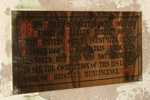 |
||
 |
|||
|
|||
 |
|||
|
|||


